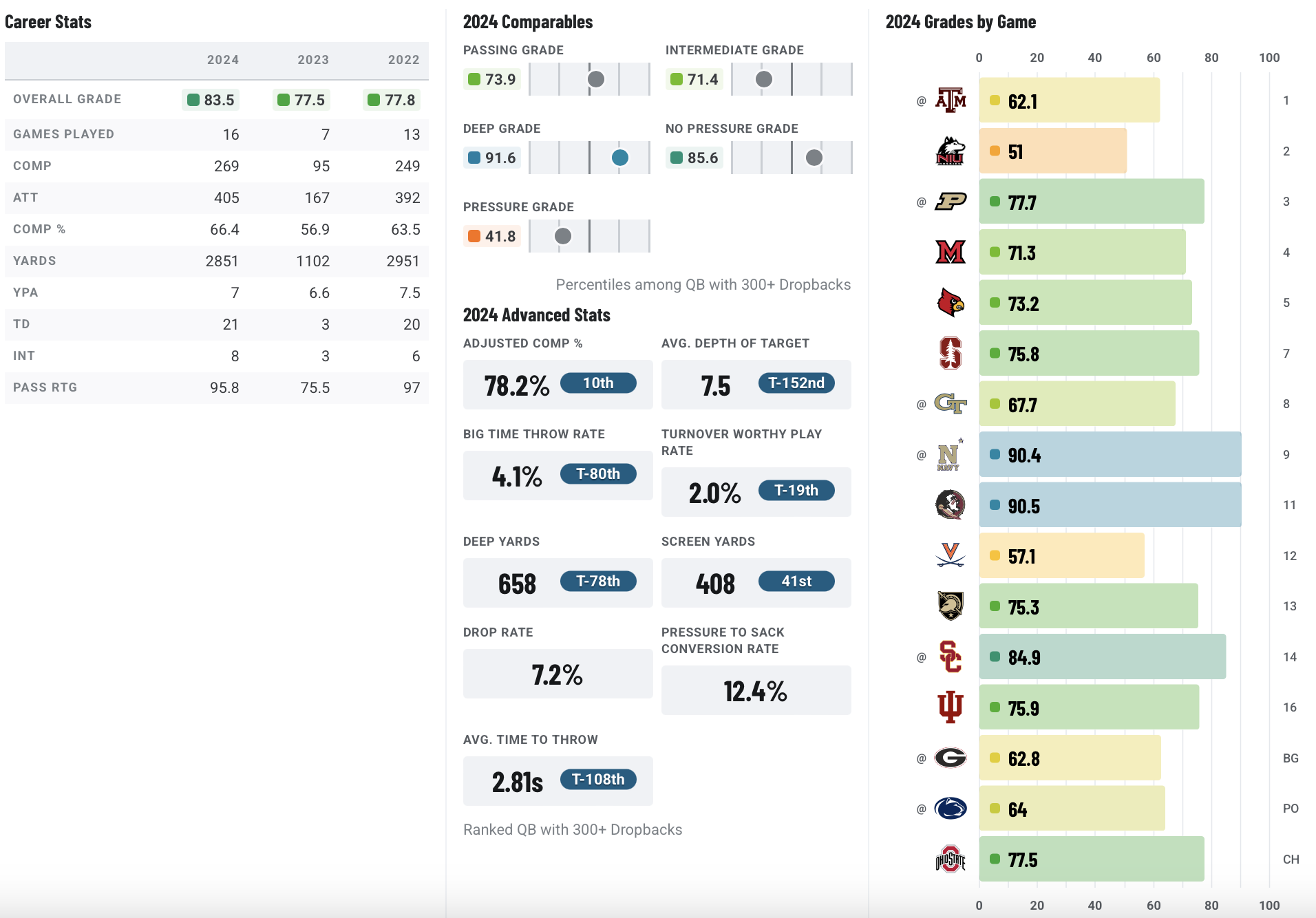
- Leonard has upside that could warrant interest: Leonard is a strong runner and excels at avoiding sacks.
- Leonard’s stable passing metrics are worrisome: The Notre Dame gunslinger finished well below the 50th percentile in most stable PFF passing metrics.
- 2025 NFL Draft season is here: Try PFF’s best-in-class Mock Draft Simulator and learn about 2025’s top prospects while trading and drafting for your favorite NFL team.
Estimated Reading Time: 4 minutes

The 2025 NFL Draft is quickly approaching, and the draft class is rounding into shape. With the PFF big board live and mock draft season in full swing, teams and analysts are gaining a clearer picture of the top prospects and the deepest position groups in this year’s class.
Projecting college football stars to the NFL is never an exact science, but using PFF grades and advanced data, we can get a clearer picture of how prospects might transition to the next level. By analyzing performance trends, key metrics and positional benchmarks, we can identify which players are best positioned to succeed — and which may face challenges — when making the jump from college to the pros.
Let’s take a look at Riley Leonard, who earned an 83.5 overall PFF grade last year with an 78.2% adjusted completion percentage. After leading the Fighting Irish to the national championship, Leonard is slotted as a likely Day 3 pick.

SCOUTING SUMMARY
Leonard is a former three-star quarterback from Fairhope, Ala., where he was a two-sport athlete and was initially torn between football and basketball. He received basketball offers from Samford, Missouri State and North Alabama after averaging more than 20 points per game as a senior but ultimately chose football, committing to Duke. He made one start as a true freshman before becoming the full-time starter for the next two seasons, though he missed a significant portion of the 2023 season due to an ankle injury. He transferred to Notre Dame, where, after a conservative start, he helped propel the team to a College Football Playoff berth and eventually played for a national championship.
Leonard is a well-built quarterback whose most alluring trait is his dual-threat ability. He is a battering ram-style runner who isn’t afraid to take off, absorb hits and do the dirty work to move the chains.
However, his passing remains too inconsistent. While he displays good throwing fundamentals, his accuracy and ball placement are issues. His early-down passing grade is among the lowest in this class, and his third-down passing stats highlight a lack of individual success — he threw past the sticks on third-and-7-plus just 35% of the time. Though he can escape the pocket and extend plays with his legs, his passing grade under pressure has been poor over the past two seasons.
Despite his inconsistencies, Leonard remains an intriguing quarterback due to his flashes of understanding progressions, timing, pocket toughness and willingness to make full-field reads.
WINS ABOVE AVERAGE
WAA represents the number of wins a player is worth over an average college football player and is a metric that evaluators can utilize to assess performance. It combines how well a player performed in each facet of play (using PFF grades) and how valuable each facet is to winning football games. The result is a first-of-its-kind metric that allows for cross-positional valuation and predicts future value at the player and team levels.
HOW RILEY LEONARD RANKS IN THE STABLE METRICS (2022-24)
Stable metrics are more reliable indicators of future success than volatile, high-variance stats. The most stable facets of a player’s performance are those measured over larger sample sizes, even if they may seem less impressive or “easier” on the surface. These metrics provide consistency, making them more predictive over time. While unstable metrics may capture highlight plays, they often fluctuate from year to year. Prioritizing stability provides a clearer picture of a player’s true ability and long-term potential.
Riley Leonard’s stable metrics profile isn’t pretty, as he ranks well below the 50th percentile in every stat listed here except for one. However, sack rate is one of the stickier metrics in college-to-pro projections, and that was a major strength in Leonard’s game during his college career.
RILEY LEONARD’S PROJECTIONS
In league-average circumstances, here are Leonard’s projections for yards per attempt and completion percentage as an NFL rookie:
Leonard’s rookie-year projections in a league-average scheme with a play-action rate of 25%, a pressure rate of 35%, a quick-throw rate (under 2.5 seconds) of 50% and a short-throw rate (before the sticks) of 63%.
Let’s look at how Leonard does when we make his situation better. With a low pressure rate, a high play-action rate and more downfield looks, we do see Leonard’s projected yards per attempt and completion percentage increase slightly. Hopefully we get to see Leonard play in these types of conditions at some point in the NFL to help fulfill his potential.
Leonard’s 2024 projections in a situation where 25% of his dropbacks have pressure and he runs play action on 30% of his dropbacks.
Let’s also look at how Leonard does when we make the situation less favorable. With a high pressure rate and a low play-action rate, Leonard’s projections don’t change drastically from the projections we ran with the first set of conditions. Leonard’s good sack rate in college suggests that he may be able to handle pressure relatively well in the NFL.
Leonard’s 2024 projections in a situation where 40% of his dropbacks have pressure and he runs play action on just 15% of his dropbacks.
BOTTOM LINE FROM PFF’s 2025 NFL DRAFT GUIDE
Leonard is a tough, dual-threat quarterback with plus value as a runner, but his passing efficiency numbers reveal too many inconsistencies on a throw-by-throw basis for him to be an NFL starter. That will have to improve if he is to be more than a backup.
This news was originally published on this post .










Be the first to leave a comment